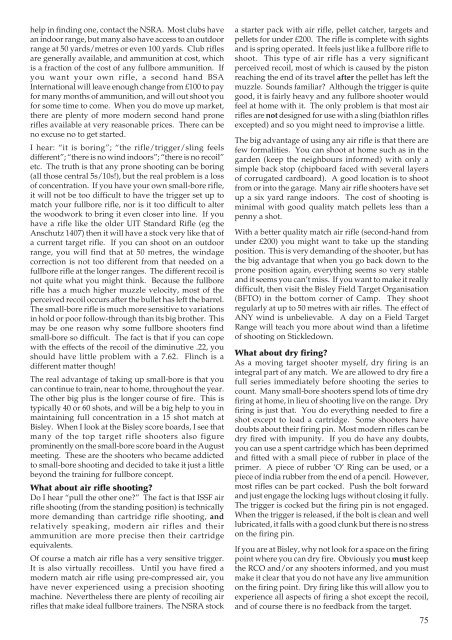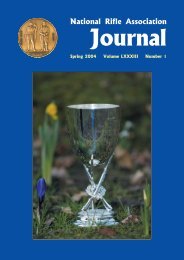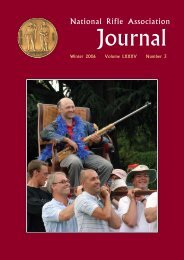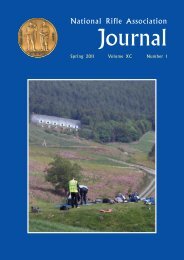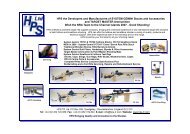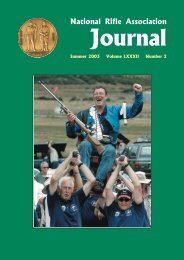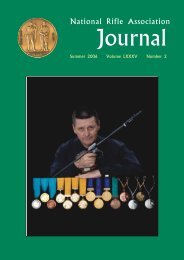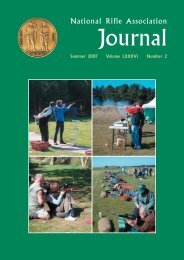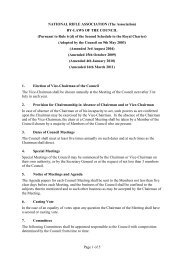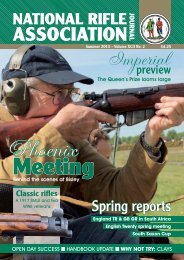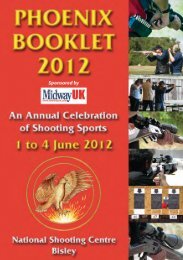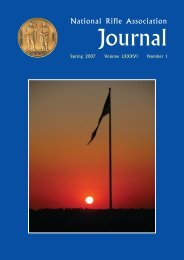Winter 2002 - National Rifle Association
Winter 2002 - National Rifle Association
Winter 2002 - National Rifle Association
- No tags were found...
You also want an ePaper? Increase the reach of your titles
YUMPU automatically turns print PDFs into web optimized ePapers that Google loves.
help in finding one, contact the NSRA. Most clubs havean indoor range, but many also have access to an outdoorrange at 50 yards/metres or even 100 yards. Club riflesare generally available, and ammunition at cost, whichis a fraction of the cost of any fullbore ammunition. Ifyou want your own rifle, a second hand BSAInternational will leave enough change from £100 to payfor many months of ammunition, and will out shoot youfor some time to come. When you do move up market,there are plenty of more modern second hand pronerifles available at very reasonable prices. There can beno excuse no to get started.I hear: “it is boring”; “the rifle/trigger/sling feelsdifferent”; “there is no wind indoors”; “there is no recoil”etc. The truth is that any prone shooting can be boring(all those central 5s/10s!), but the real problem is a lossof concentration. If you have your own small-bore rifle,it will not be too difficult to have the trigger set up tomatch your fullbore rifle, nor is it too difficult to alterthe woodwork to bring it even closer into line. If youhave a rifle like the older UIT Standard <strong>Rifle</strong> (eg theAnschutz 1407) then it will have a stock very like that ofa current target rifle. If you can shoot on an outdoorrange, you will find that at 50 metres, the windagecorrection is not too different from that needed on afullbore rifle at the longer ranges. The different recoil isnot quite what you might think. Because the fullborerifle has a much higher muzzle velocity, most of theperceived recoil occurs after the bullet has left the barrel.The small-bore rifle is much more sensitive to variationsin hold or poor follow-through than its big brother. Thismay be one reason why some fullbore shooters findsmall-bore so difficult. The fact is that if you can copewith the effects of the recoil of the diminutive .22, youshould have little problem with a 7.62. Flinch is adifferent matter though!The real advantage of taking up small-bore is that youcan continue to train, near to home, throughout the year.The other big plus is the longer course of fire. This istypically 40 or 60 shots, and will be a big help to you inmaintaining full concentration in a 15 shot match atBisley. When I look at the Bisley score boards, I see thatmany of the top target rifle shooters also figureprominently on the small-bore score board in the Augustmeeting. These are the shooters who became addictedto small-bore shooting and decided to take it just a littlebeyond the training for fullbore concept.What about air rifle shooting?Do I hear “pull the other one?” The fact is that ISSF airrifle shooting (from the standing position) is technicallymore demanding than cartridge rifle shooting, andrelatively speaking, modern air rifles and theirammunition are more precise then their cartridgeequivalents.Of course a match air rifle has a very sensitive trigger.It is also virtually recoilless. Until you have fired amodern match air rifle using pre-compressed air, youhave never experienced using a precision shootingmachine. Nevertheless there are plenty of recoiling airrifles that make ideal fullbore trainers. The NSRA stocka starter pack with air rifle, pellet catcher, targets andpellets for under £200. The rifle is complete with sightsand is spring operated. It feels just like a fullbore rifle toshoot. This type of air rifle has a very significantperceived recoil, most of which is caused by the pistonreaching the end of its travel after the pellet has left themuzzle. Sounds familiar? Although the trigger is quitegood, it is fairly heavy and any fullbore shooter wouldfeel at home with it. The only problem is that most airrifles are not designed for use with a sling (biathlon riflesexcepted) and so you might need to improvise a little.The big advantage of using any air rifle is that there arefew formalities. You can shoot at home such as in thegarden (keep the neighbours informed) with only asimple back stop (chipboard faced with several layersof corrugated cardboard). A good location is to shootfrom or into the garage. Many air rifle shooters have setup a six yard range indoors. The cost of shooting isminimal with good quality match pellets less than apenny a shot.With a better quality match air rifle (second-hand fromunder £200) you might want to take up the standingposition. This is very demanding of the shooter, but hasthe big advantage that when you go back down to theprone position again, everything seems so very stableand it seems you can’t miss. If you want to make it reallydifficult, then visit the Bisley Field Target Organisation(BFTO) in the bottom corner of Camp. They shootregularly at up to 50 metres with air rifles. The effect ofANY wind is unbelievable. A day on a Field TargetRange will teach you more about wind than a lifetimeof shooting on Stickledown.What about dry firing?As a moving target shooter myself, dry firing is anintegral part of any match. We are allowed to dry fire afull series immediately before shooting the series tocount. Many small-bore shooters spend lots of time dryfiring at home, in lieu of shooting live on the range. Dryfiring is just that. You do everything needed to fire ashot except to load a cartridge. Some shooters havedoubts about their firing pin. Most modern rifles can bedry fired with impunity. If you do have any doubts,you can use a spent cartridge which has been deprimedand fitted with a small piece of rubber in place of theprimer. A piece of rubber ‘O’ Ring can be used, or apiece of india rubber from the end of a pencil. However,most rifles can be part cocked. Push the bolt forwardand just engage the locking lugs without closing it fully.The trigger is cocked but the firing pin is not engaged.When the trigger is released, if the bolt is clean and welllubricated, it falls with a good clunk but there is no stresson the firing pin.If you are at Bisley, why not look for a space on the firingpoint where you can dry fire. Obviously you must keepthe RCO and/or any shooters informed, and you mustmake it clear that you do not have any live ammunitionon the firing point. Dry firing like this will allow you toexperience all aspects of firing a shot except the recoil,and of course there is no feedback from the target.75


